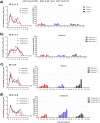Effect of Baloxavir and Oseltamivir in Combination on Infection with Influenza Viruses with PA/I38T or PA/E23K Substitutions in the Ferret Model
- PMID: 35938724
- PMCID: PMC9426601
- DOI: 10.1128/mbio.01056-22
Effect of Baloxavir and Oseltamivir in Combination on Infection with Influenza Viruses with PA/I38T or PA/E23K Substitutions in the Ferret Model
Abstract
Amino acid substitutions I38T and E23K in the influenza polymerase acidic (PA) protein lead to reduced susceptibility to the influenza antiviral drug baloxavir. The in vivo effectiveness of baloxavir and oseltamivir for treatment of these viruses is currently unknown. Using patient-derived influenza isolates, combination therapy was equally effective as monotherapy in reducing viral titers in the upper respiratory tract of ferrets infected with A(H1N1pdm09)-PA/E23K or A(H3N2)-PA/I38T. When treated with baloxavir plus oseltamivir, infection with a mixture of PA/I38T or PA/E23K and corresponding wild-type virus was characterized by a lower selection of viruses with reduced baloxavir susceptibility over the course of infection compared to baloxavir monotherapy. De novo emergence of the oseltamivir resistance mutation NA/H275Y occurred in ferrets treated with oseltamivir alone but not in ferrets treated with baloxavir plus oseltamivir. Our data suggest that combination therapy with influenza drugs with different mechanisms of action decreased the selection pressure for viruses with reduced drug susceptibility. IMPORTANCE Influenza viruses cause significant morbidity and mortality worldwide but can be treated with antiviral drugs. In 2018, a highly effective antiviral drug, baloxavir marboxil, was licensed. However, the selection of viruses with baloxavir resistance was relatively high following treatment, which may compromise the effectiveness of the drug. Here, we took two different influenza viruses that are resistant to baloxavir and tested the effectiveness alone and in combination with oseltamivir (a second influenza antiviral drug) in the ferret model. Our findings suggest that combination treatment may be a more effective method than monotherapy to reduce the selection of resistant viruses. These results may have important clinical implications for the treatment of influenza.
Keywords: antiviral agents; antiviral resistance; ferret; influenza; virus.
Conflict of interest statement
The authors declare a conflict of interest. Aeron Hurt is an employee and stockholder of F. Hoffmann-La Roche Ltd.
Figures





Similar articles
-
Impact of the Baloxavir-Resistant Polymerase Acid I38T Substitution on the Fitness of Contemporary Influenza A(H1N1)pdm09 and A(H3N2) Strains.J Infect Dis. 2020 Jan 1;221(1):63-70. doi: 10.1093/infdis/jiz418. J Infect Dis. 2020. PMID: 31419295 Free PMC article.
-
Detection of influenza A(H3N2) viruses with polymerase acidic subunit substitutions after and prior to baloxavir marboxil treatment during the 2022-2023 influenza season in Japan.Antiviral Res. 2024 Sep;229:105956. doi: 10.1016/j.antiviral.2024.105956. Epub 2024 Jul 4. Antiviral Res. 2024. PMID: 38969237
-
Influenza A virus polymerase acidic protein E23G/K substitutions weaken key baloxavir drug-binding contacts with minimal impact on replication and transmission.PLoS Pathog. 2022 Jul 13;18(7):e1010698. doi: 10.1371/journal.ppat.1010698. eCollection 2022 Jul. PLoS Pathog. 2022. PMID: 35830486 Free PMC article.
-
Global update on the susceptibilities of human influenza viruses to neuraminidase inhibitors and the cap-dependent endonuclease inhibitor baloxavir, 2018-2020.Antiviral Res. 2022 Apr;200:105281. doi: 10.1016/j.antiviral.2022.105281. Epub 2022 Mar 12. Antiviral Res. 2022. PMID: 35292289 Free PMC article. Review.
-
Pharmacologic background and clinical issue of anti-influenza drugs.Fukushima J Med Sci. 2025 Jan 18;71(1):1-12. doi: 10.5387/fms.24-00029. Epub 2024 Dec 18. Fukushima J Med Sci. 2025. PMID: 39694499 Free PMC article. Review.
Cited by
-
The real-world safety of oseltamivir and baloxavir marboxil in children: a disproportionality analysis of the FDA adverse event reporting system.Front Pharmacol. 2024 Jul 10;15:1391003. doi: 10.3389/fphar.2024.1391003. eCollection 2024. Front Pharmacol. 2024. PMID: 39050747 Free PMC article.
-
Drug repositioning as a promising approach for the eradication of emerging and re-emerging viral agents.Mol Divers. 2025 Mar 18. doi: 10.1007/s11030-025-11131-8. Online ahead of print. Mol Divers. 2025. PMID: 40100484 Review.
-
PA-E18G substitution in influenza A virus confers resistance to ZX-7101, a cap-dependent endonuclease inhibitor.Virol Sin. 2023 Aug;38(4):559-567. doi: 10.1016/j.virs.2023.06.002. Epub 2023 Jun 7. Virol Sin. 2023. PMID: 37290559 Free PMC article.
-
Safety and effectiveness of baloxavir marboxil and oseltamivir for influenza in children: a real-world retrospective study in China.Front Pediatr. 2024 Jul 29;12:1418321. doi: 10.3389/fped.2024.1418321. eCollection 2024. Front Pediatr. 2024. PMID: 39135856 Free PMC article.
-
Real-world effectiveness and safety of Baloxavir Marboxil or Oseltamivir in outpatients with uncomplicated influenza A: an ambispective, observational, multi-center study.Front Microbiol. 2024 Jul 23;15:1428095. doi: 10.3389/fmicb.2024.1428095. eCollection 2024. Front Microbiol. 2024. PMID: 39109213 Free PMC article.
References
-
- Noshi T, Yamamoto A, Kawai M, Yoshida R, Sato A, Shishido T, Naito A. 2016. S-033447/S-033188, a novel small molecule inhibitor of cap-dependent endonuclease of influenza A and B virus: in vitro antiviral activity against clinical strains. Poster presentation, OPTIONS IX. European Centre for Disease Prevention and Control, Solna, Sweden.
-
- Noshi T, Kitano M, Taniguchi K, Yamamoto A, Omoto S, Baba K, Hashimoto T, Ishida K, Kushima Y, Hattori K, Kawai M, Yoshida R, Kobayashi M, Yoshinaga T, Sato A, Okamatsu M, Sakoda Y, Kida H, Shishido T, Naito A. 2018. In vitro characterization of baloxavir acid, a first-in-class cap-dependent endonuclease inhibitor of the influenza virus polymerase PA subunit. Antiviral Res 160:109–117. doi:10.1016/j.antiviral.2018.10.008. - DOI - PubMed
-
- Takashita E, Daniels RS, Fujisaki S, Gregory V, Gubareva LV, Huang W, Hurt AC, Lackenby A, Nguyen HT, Pereyaslov D, Roe M, Samaan M, Subbarao K, Tse H, Wang D, Yen H-L, Zhang W, Meijer A. 2020. Global update on the susceptibilities of human influenza viruses to neuraminidase inhibitors and the cap-dependent endonuclease inhibitor baloxavir, 2017–2018. Antiviral Res 175:104718. doi:10.1016/j.antiviral.2020.104718. - DOI - PubMed
-
- Hayden FG, Sugaya N, Hirotsu N, Lee N, de Jong MD, Hurt AC, Ishida T, Sekino H, Yamada K, Portsmouth S, Kawaguchi K, Shishido T, Arai M, Tsuchiya K, Uehara T, Watanabe A. 2018. Baloxavir marboxil for uncomplicated influenza in adults and adolescents. N Engl J Med 379:913–923. doi:10.1056/NEJMoa1716197. - DOI - PubMed
MeSH terms
Substances
LinkOut - more resources
Full Text Sources
Medical

